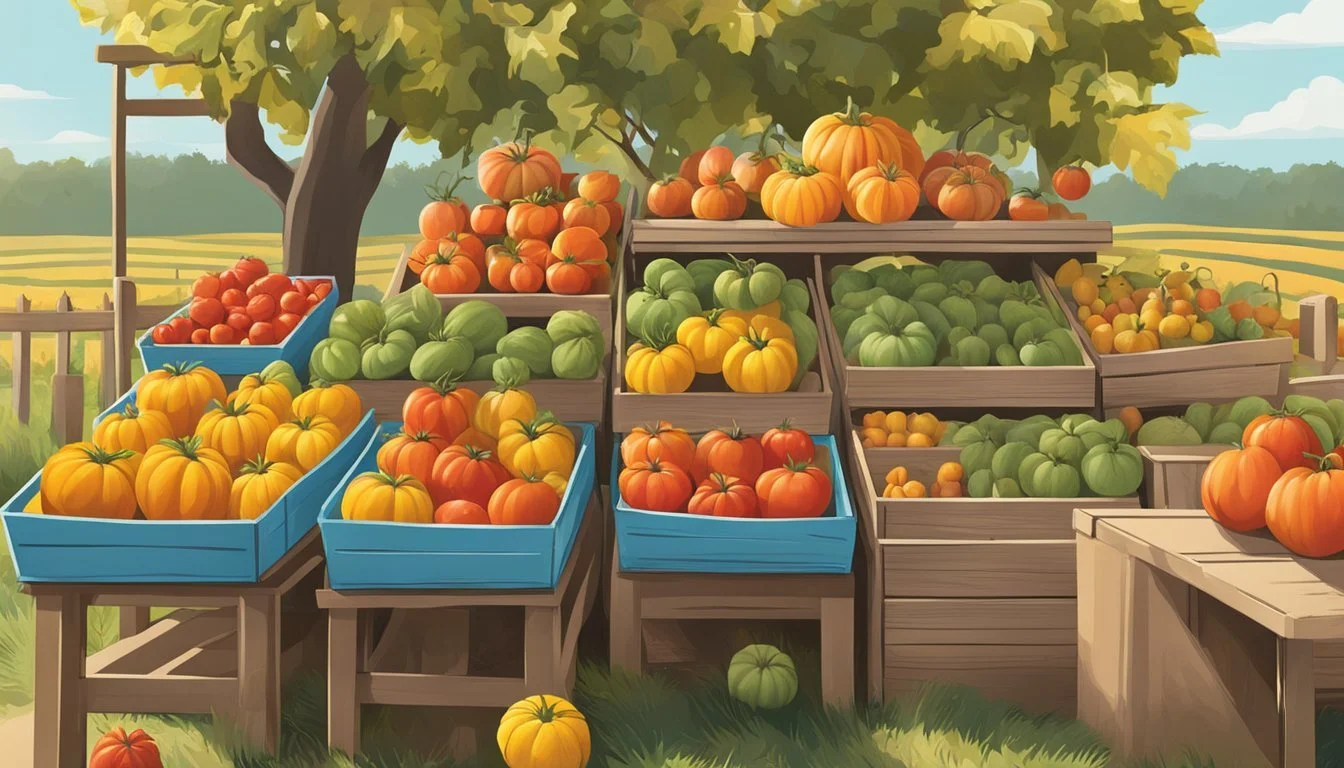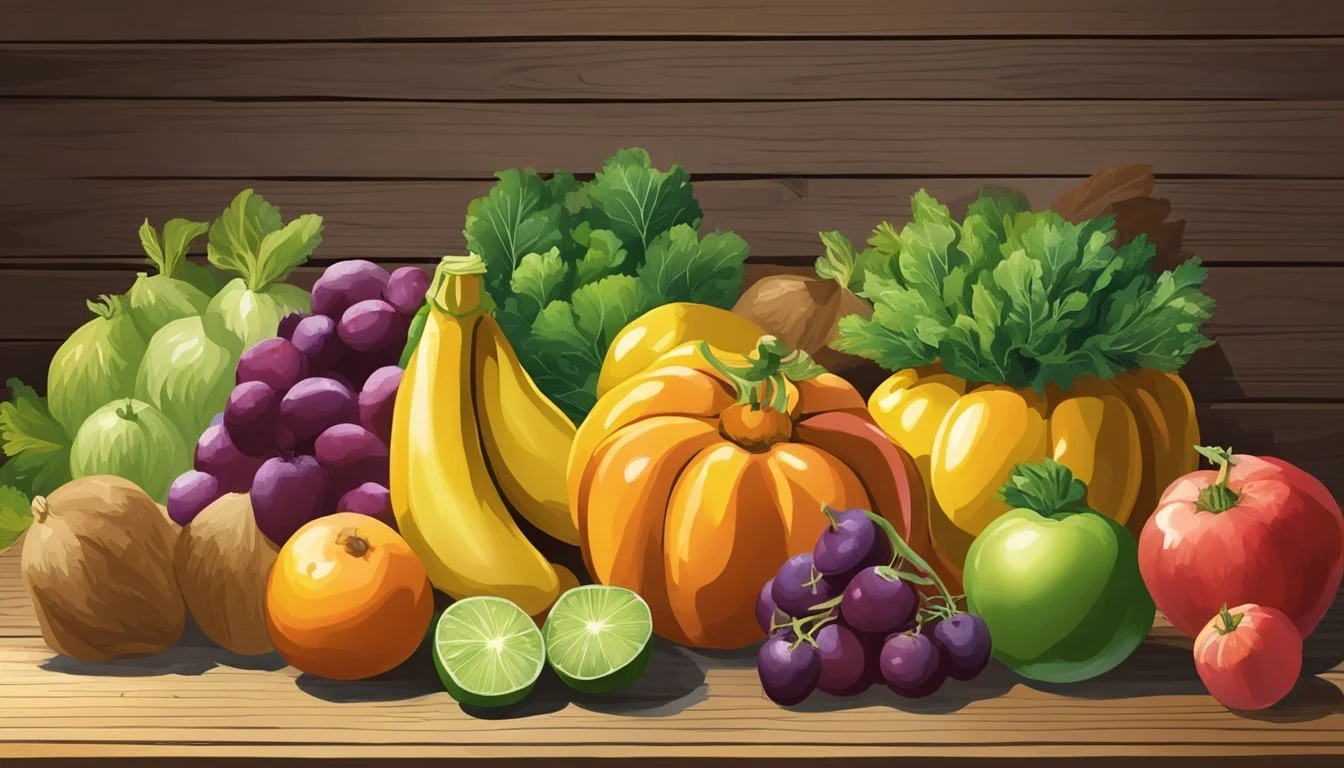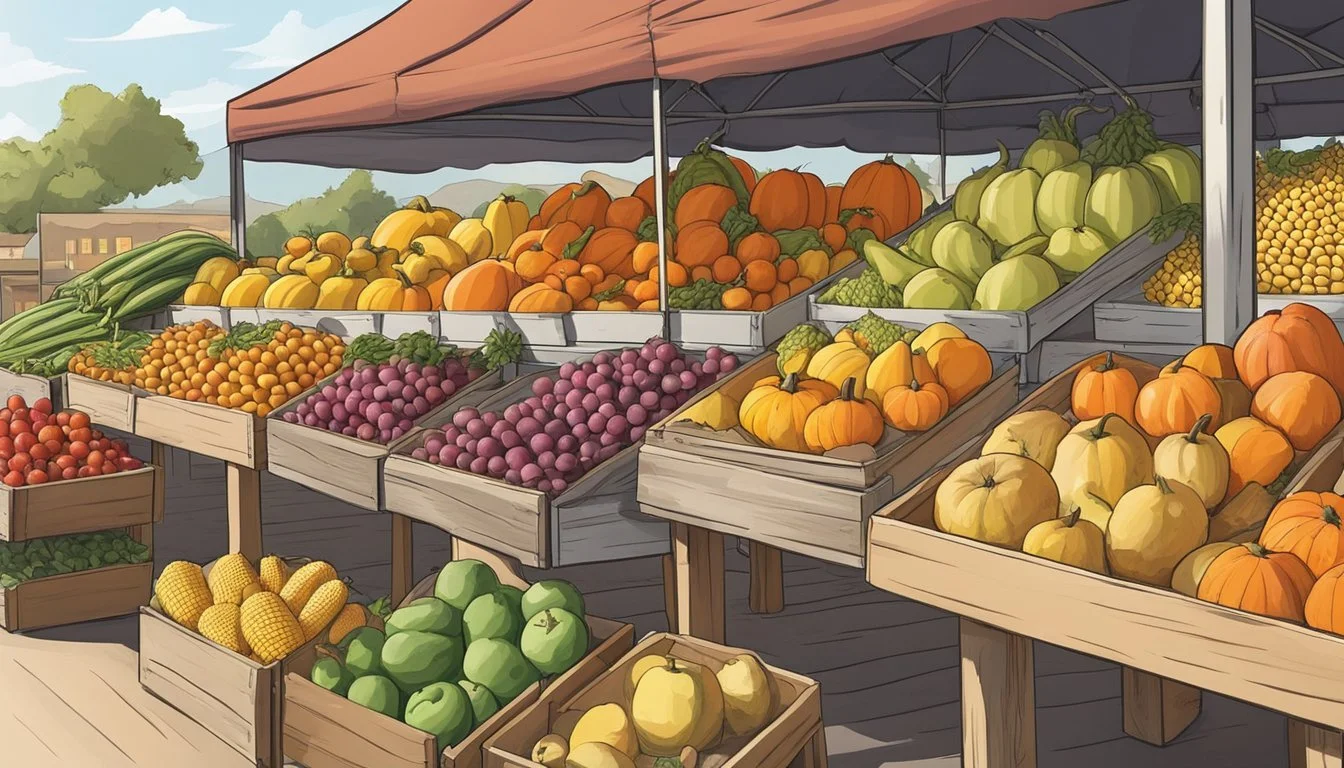Wyoming Seasonal Fruit & Vegetables in September
Your Harvest Guide
This Article is Part of our Wyoming Seasonal Fruit & Veg Calendar
September in Wyoming heralds the transition from summer's abundance to the heartier selections of fall. The state's diverse climate and geography, from plains to mountains, create varying growing conditions that influence the produce available during this month. Farmers and home gardeners alike harvest the last of the summer crops, while the first of the autumn bounty starts to become available.
Fruits (What wine goes well with fruit?) like apples (how long do apples last?) reach peak ripeness, and the cooler evenings contribute to their crispness and flavor. Vegetables such as cauliflower and bell peppers are also in season, offering a rich palette for culinary exploration. The harvest is celebrated across Wyoming, with local markets brimming with fresh, seasonal produce, reflecting the agricultural heritage and community spirit of the region.
Canning and preserving become popular activities as residents of Wyoming prepare for the winter months. This practice not only extends the enjoyment of September's harvest but also highlights the importance of self-sufficiency in the local cuisine. Seasonal eating in Wyoming during this month supports local farmers, reduces the carbon footprint, and provides the freshest ingredients for nourishing and flavorful meals.
Seasonal Fruits Overview
Wyoming's September produce offers a diverse palette of flavors as it transitions from the abundant summer harvest into the heartier selections of fall.
Summer to Fall Transition Fruits
In this period, apples and pears become particularly noteworthy for their crisp textures and a balance of sweet and tart flavors. Numerous varieties of these fruits reach their peak during September, offering an array of options for consumers.
Apples: Ripe and ready in varieties that range from the rosy-hued Gala to the tart and crisp Granny Smith.
Pears: Soft, buttery textures available in Bartlett and Bosc varieties, perfect for both fresh consumption and culinary uses.
Berries and Stone Fruits
Berries gradually give way to the end of their season, with blackberries and raspberries still available, providing a juicy and sweet burst of flavor. Meanwhile, stone fruits like plums continue to be harvested, their unique flavors captured just before the cold sets in.
Blackberries: Juicy and sweet, often found in wild patches and at local markets.
Raspberries: Delicately sweet with a vibrant color.
Plums: Offered in a range of types, from the firm and sweet to the brightly tart.
Melons and Exotic Varieties
September also sees a range of melons, with cantaloupe (how long does cantaloupe last?) being a standout for its rich, musky sweetness. Exotic varieties of fruit may become available, including those not native to Wyoming but still enjoyed during this season due to modern shipping practices.
Cantaloupe: Aromatic and sweet, encapsulating the essence of summer.
Exotic Varieties: Availability may vary, but often includes fruits such as figs or papayas, providing a tropical flair amidst fall's onset.
Each of these fruits represents the merging timelines of produce in Wyoming, catering to those savoring the last notes of summer while anticipating fall's full arrival.
Seasonal Vegetables Overview
In September, Wyoming offers a rich palette of vegetables that thrive in the transition from summer to autumn. The seasonal produce is known for its firm texture and vibrant colors, with many vegetables best enjoyed both raw in salads and cooked in heartier dishes.
Root Vegetables and Squash
Root vegetables like potatoes, carrots (how long do carrots last?), and beets reach peak maturity in September, offering a sweet and earthy flavor profile. They can be enjoyed raw, adding a crisp texture to salads, or cooked, where they develop a tender and comforting quality. Winter squash and pumpkins come into season, boasting firm flesh that is ideal for baking and roasting.
Potatoes: Versatile and hearty, perfect for a variety of dishes.
Carrots: Crunchy when raw and sweet when roasted.
Beets: Deep, earthy flavor, often roasted or pickled.
Winter Squash: Includes varieties like acorn and butternut, known for its sweet taste.
Pumpkins: Not just for carving, these are excellent in soups and pies.
Leafy Greens and Legumes
The cooler nights of Wyoming's September are conducive to the growth of leafy greens such as spinach and kale. They retain a fresh, crispness that enlivens salads and smoothies. Legumes like beans and peas offer a combination of tender texture and protein, making them a staple in soups and stews.
Spinach: Tender leaves, ideal for salads and smoothies.
Kale: Sturdy and nutrient-rich, great for chips or sautéed dishes.
Beans: Include green beans, which are crisp and snappy.
Peas: Sweet and firm, easily added to a variety of dishes.
Nightshades and Others
Nightshade vegetables, such as tomatoes, peppers, and eggplants (how long does eggplant last?), are still in abundance in September. The end of summer warmth helps concentrate their flavors. Tomatoes range from sweet cherry varieties to robust beefsteaks, perfect for fresh salads or sauces. Peppers add a pop of color and can vary in flavor from sweet to spicy. Eggplants with their glossy, purple skin are versatile, fitting well in dishes from baba ganoush to parmesan.
Tomatoes: From juicy to dense and meaty, suited for a wide range of culinary uses.
Peppers: Bell peppers are sweet, while varieties like jalapeños bring heat.
Eggplants: Absorbent and creamy when cooked, excellent in many global cuisines.
Other non-nightshade vegetables like cucumbers remain crisp and cool, providing a refreshing crunch to the late summer palate. They transition well into early autumn, retaining their hydrating quality in an array of dishes.
Harvesting Practices
In September, Wyoming’s agricultural attention shifts to harvesting, a critical period where timing and methods determine the quality of the produce. Farmers monitor crops closely, as the region’s variable climate can affect ripening.
For root vegetables such as carrots and potatoes, they are typically harvested when foliage begins to yellow and die back. A gentle lift from the soil and brushing off dirt is sufficient.
Tomatoes, peppers, and eggplants should be harvested when they attain full color but are still firm to the touch. If temperatures start to drop, they may be picked slightly underripe and allowed to ripen indoors.
Beans, cucumbers, melons, and zucchinis cease to ripen once picked. These should be picked continually to encourage further production. For beans, a snap sound indicates perfect picking time, while cucumbers and zucchinis are best when medium-sized.
Leafy greens such as lettuce and spinach are cut at the base, allowing the possibility of a second growth spurt if the season allows.
Fruit trees, abundant with apples and pears in Wyoming, bear produce that is typically twisted gently to detach when ripe. The firmness of the fruit and the ease of the stem's detachment are reliable indicators of readiness.
To preserve fruit and vegetable quality post-harvest, proper storage methods are necessary. While many vegetables can stay in a cool, dry place, fruit often requires immediate cooling to maintain freshness.
Crop Type Harvest Sign Harvest Method Root vegetables Yellowing foliage Gently lift and brush off soil Nightshades (tomatoes, etc.) Full color and firm Harvest slightly underripe if needed Beans and vine crops Pod snap and medium size Pick continually Leafy greens Mature leaves Cut at the base
Farmers proceed with assurance derived from generations of experience, coupled with a deep understanding of their unique Wyoming terrain and climate. While September marks the year's dwindling warmth, Wyoming’s harvesters make use of every favorable day to secure their hard-earned bounty.
Health Benefits
Eating fresh, seasonal fruits and vegetables in September in Wyoming offers numerous health advantages. They are abundant in vital nutrients that contribute to overall wellbeing.
Seasonal produce tends to be richer in vitamins and minerals. For instance, dark leafy greens and cruciferous vegetables available during this month are excellent sources of iron and calcium, essential for maintaining strong bones and healthy blood.
Including fruit and vegetables like pumpkins and apples in one’s diet increases fiber intake, vital for digestive health. Fiber also aids in maintaining a healthy weight and reducing cholesterol levels, which directly supports heart health.
Wyoming's September harvest includes berries and tomatoes, which are high in antioxidants. These compounds counteract oxidative stress and may reduce the risk of chronic diseases. Furthermore, antioxidants have been linked to improved cognitive function and skin health.
Consuming a variety of colorful produce ensures a diverse intake of these health-promoting nutrients. To illustrate:
Produce Nutrient Benefit Berries Antioxidants, Fiber Leafy Greens Iron, Calcium, Fiber Pumpkins Antioxidants, Fiber Tomatoes Antioxidants, Vitamin C
By embracing seasonal eating, individuals not only enjoy fresher food but also support local agriculture and reduce their environmental footprint. This practical approach aligns with a conscious lifestyle, bringing together nutrition and sustainability.
Culinary Uses
In Wyoming, the September harvest yields a bounty of fruits and vegetables ideal for a range of culinary applications. Preservation techniques ensure longevity while cooking methods and recipes can transform these ingredients into flavorful dishes.
Preservation Techniques
Fruits and vegetables can be kept fresh through proper preservation. The fridge serves as a common storage method, extending the life of most produce when kept in airtight containers. Pickling is a popular choice for cucumbers, beets, and peppers, offering both extended shelf life and a zesty flavor. For fruits, making jams or jellies can preserve the tastes of summer.
Preservation Method Related Produce Expected Shelf Life Refrigeration Leafy greens, herbs 1-2 weeks Airtight Containers Berries, cut veggies 5-7 days Pickling Cucumbers, beets Several months Jam/Jelly Making Berries, apples Up to a year
Cooking Methods
Wyoming's seasonal produce can be enjoyed using various cooking methods that enhance their natural flavors. Fruits like apples and pears can be baked into desserts providing a sweet and smooth addition. Vegetables such as squash can be roasted for a caramelized edge or fried for a satisfying crunch. Many vegetables are also perfect for making hearty soups or adding a fresh, crisp element to salads.
Roasting: Squash, carrots, potatoes
Frying: Eggplant, peppers
Baking: Apples for pies, pears for tarts
Steaming: Green beans, broccoli
Recipe Ideas
Every ingredient found in Wyoming's September harvest can be incorporated into a vast array of dishes. Tomatoes can be used in fresh salads or simmered down into soups. Squash makes for a comforting addition to autumnal recipes, while apples and pears can be the centerpiece of various desserts. Herbs enhance flavors across the board, whether in a soup, dressing for a salad, or marinade for meats.
Salads:
Tomato and basil salad
Roasted beet and goat cheese salad
Soups:
Butternut squash soup
Potato and leek soup
Desserts:
Apple crumble
Pear tart
Snack:
Fresh carrot sticks with hummus
Apple slices with almond butter
Buying Guide
When seeking out the freshest and most flavorful fruits and vegetables in Wyoming during September, shoppers should focus on items that are in peak season. A discerning eye for quality and proper storage methods are essential to maximize freshness and extend shelf life.
Selecting the Best Produce
To ensure one is purchasing high-quality produce, certain characteristics should be assessed:
Fruits: Look for fruits that are firm and vibrant in color. The skin should be intact without bruises or soft spots. For example, apples should be firm to the touch and have a smooth, unblemished skin.
Vegetables: Vegetables should be tender yet firm. Rich, deep hues generally indicate good flavor and high nutrient content. Leafy greens, like kale and spinach, should look fresh without any yellowing or wilting.
Storage Tips
Proper storage is crucial for maintaining the freshness of fruits and vegetables. Here are some storage tips to keep in mind:
Temperature: Most fruits and heirloom vegetables should be stored in a fridge, in an airtight container, to retain their freshness. Apples, for instance, can last several weeks if refrigerated.
Shelf Life: Different produce has varying shelf lives. Vegetables like carrots and leafy greens should be consumed within a week for optimal quality.
By meticulously selecting and properly storing produce, consumers can enjoy the highest quality of in-season fruits and vegetables that Wyoming has to offer in September.
Local Farming and Economics
Wyoming's agricultural sector plays a significant role in the state's economy, with local farms contributing to both employment and revenue. In September, these farms gear up for the harvest season, bringing an array of fruits and vegetables to markets and contributing to the economic resilience of local communities.
Local Produce: A Snapshot
Fruits: Apples, Pears
Vegetables: Beets, Carrots, Spinach
Local farmers often engage in Community Supported Agriculture (CSA) operations and farmers' markets, providing fresh, seasonal produce to residents. CSAs like the Veggie Box Program foster direct economic interaction between consumers and producers, with members receiving regular shares of produce throughout the harvest season. This exchange supports farmers' financial stability by ensuring a consistent market for their goods.
Local farmers' markets also stimulate the economy by creating avenues for small-scale producers to sell their goods directly to consumers, enhancing the local food system's sustainability. The presence of a diverse array of produce at these markets reflects the successful harvesting period and underscores the importance of agriculture to Wyoming's economy.
Moreover, agritourism associated with farms, such as pumpkin patches and orchards, peaks in the fall. This draws visitors from across the state and beyond, integrating local agriculture with Wyoming's wider economy. The subsequent increase in spendings, such as on "U-pick" experiences and farm tours, bolsters the economic landscape, emphasizing the interdependence of the state's agriculture and tourism sectors.
Environmental Considerations
When discussing the cultivation of seasonal fruits and vegetables in Wyoming during September, sustainability is at the forefront. Farmers and consumers alike benefit from organic farming practices that support the local ecosystem and reduce harmful impacts on the environment.
Organic Farming: This practice minimizes chemical inputs and fosters soil health. It aids in maintaining the natural biodiversity of Wyoming, which is essential to a robust agricultural framework.
Seasonality: Harvesting crops during their natural growing season reduces the demand for off-season produce, which often requires additional resources like heat and lighting. By focusing on seasonal produce, such as squash and apples in September, resources are preserved, and the carbon footprint from transportation and artificial climate control is minimized.
Impact of Heat and Climate: Wyoming's September climate is generally milder, offering ideal conditions for certain crops suited for the cooler temperatures. This natural advantage allows for less resource-intensive farming, as there is reduced need for irrigation and climate intervention.
Sustainability: Consumers can facilitate sustainable practices by purchasing locally grown, September-harvested produce. This action directly supports regional agriculture and mitigates the transportation emissions associated with long-distance food distribution.
In essence, the environmental considerations for Wyoming's September produce revolve around embracing organic methods, prioritizing seasonality, and understanding the interplay between natural heat and climate. These factors all conjoin to create a more sustainable agricultural system.
Seasonal Events and Festivals
In September, Wyoming celebrates the harvest with a variety of community-centric festivals and events. They offer residents and visitors an authentic state experience through a showcase of local produce, crafts, and cultural activities.
Rock Springs Fall into Fall Festival: A highlight in September is the "Fall into Fall Festival" in Rock Springs, where attendees can enjoy local food vendors, entertainment, and the warmth of a small-town carnival atmosphere.
Wyoming Fall Guide Events: Throughout the state, several pop-up events take place. The "September Pop-Up Dog Park" appears at the Village Green from dawn to dusk, providing a pet-friendly festival environment.
Local Markets: Markets, such as the "Fall Market at the Work+Shop", operate full of local vendors. These markets typically run during specific hours, like 10 a.m to 2 p.m, and feature seasonal goods, which may include produce from the harvest.
The events are not only a celebration but also a vital part of the state's agricultural promotion, informing visitors about the season’s harvest. Interested individuals can follow event updates and vendor lists on related social media platforms like Instagram.
These festivals and events reflect Wyoming's commitment to fostering community spirit and promoting local agriculture. Each gathering allows people to connect over the shared appreciation of the season's bounty while supporting local farmers and artisans.










